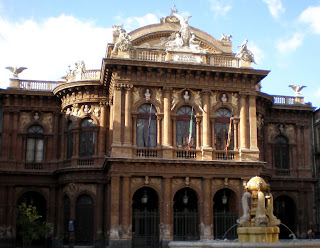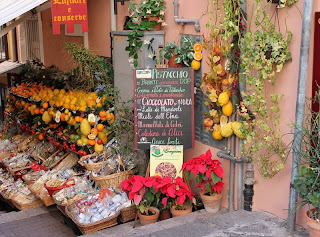We have travelled through Italy and Sicily for the past few months, stopped at various historical sights pertaining to WW2, only to find that very little mention is made of Italy's participation in that war. We came across this exception in the central piazza in Vittoria, Sicily, although upon first examination of the marble plaque, it is not at all obvious as to who the man is. No mention is made of the Second World War. What drew my attention is the inscription 'Military Medal for Valour'.
Deputy Sergeant Salvatore D' Acquisto (1920-1943)
Military Medal for Valour - Gold
Italian Carabinieri
Below an edited extraction from an article in the Catholic Herald:-
Modern Italy has few war heroes. One soldier from the WW2 period (1939-1945) is however honoured; he has squares, schools and streets named after him. He is an NCO named Salvo D’Aquisto, who died aged 22. He has a simple tomb in Santa Chiara, the most beautiful church, in his native Naples, and in Italy they are waiting for him to be canonised; when that happens
Salvo D’Acquisto will be the first 'soldier saint' of the Second World War.
He was the eldest of eight children: three died in infancy, one in childhood; the youngest brother is still alive and living in Naples, and is now in his late seventies. The entire family, including a formidable grandmother, all lived in one large room in the Vomero quarter.
They were not particularly poor by the standards of the time. Their father worked in a chemical factory. Salvo himself was a studious child, even bookish, but still left school aged 14, as working-class boys did in those days.
At 18, the minimum age, having done a few jobs in the meantime, he enrolled in the
Carabinieri, the oldest regiment in the Italian Army, which carries out the functions of a police force. Archbishop Giovanni Marra, Italy’s military bishop, describes Salvo as tall, athletic and with limpid eyes, "a true son of Southern Italy", and so he was in more than just looks. No less than four of his immediate male relatives had enrolled in the Carabinieri a sure sign then that there were few alternative careers available for a talented but poor Neapolitan. He spent 18 months in North Africa on active service; he was recalled, promoted to NCO, and had his last posting in a little village north of Rome.
But these are only facts; one gazes at photographs, reads his letters home, and speaks to his brother. From these pieces a mosaic emerges of the life of the man who now lies in Santa Chiara. “So quiet you would hardly think he was Neapolitan,” a schoolmaster of Salvo says.
One sees the young soldier paddling in the Mediterranean, in grainy black and white; or wearing a pith helmet in Libya, smiling. “You are just the type of Neapolitan girl that I have always had in my heart and so much prized,” he writes to his madrina di guerra, a young lady called Maria, who, as was the custom, had sent him her photograph, along with a picture of the Sacred Heart, to bolster his morale. “I’ll keep them both next to my heart,” he tells her. A typical son of the Italian South.
But there is more than that: his letters to his parents and to his madrina di guerra have a peculiar quality about them. No one could write them today. In seeking the man who lies in Santa Chiara one enters a lost world of purity and innocence.
When Italy changed sides in September 1943, Salvo was at his post at Torrimpietra, north of Rome.
His commanding officer had been called to Rome that day, and Salvo was thus, at the age of 22, the senior representative of the Italian State police (Carabinieri) in Torrimpietra. At 08:00 that morning a party of Germans arrived, wearing the uniform of the dreaded SS. Salvo, ever polite, went to greet them, holding out a hand only to be struck by a rifle and taken away without even time to put on his jacket. What had happened was this; the day before, the SS, in occupying a medieval tower at nearby Palidoro had caused an explosion. One German was dead, two wounded, and sabotage suspected.
Despite the fact that the explosion was accidental, the commander of the SS had decided on reprisals. Twenty two local men had been rounded up and were going to be shot unless Salvo could point out the person responsible for the supposed crime.
It was to be a long day. Those arrested were ordered to dig a trench, some of them with their bare hands. The process of digging their own mass grave reduced many of them to tears. Only Salvo kept calm and tried to reason with the SS. In vain. It was only at 5pm that he at last succeeded in persuading the SS to let their prisoners go. One of the prisoners stayed to see the outcome, while the others fled in gratitude. He was a 17-year-old boy, and the sole witness of Salvo’s death at the hands of the SS firing squad. For Salvo had convinced the Germans that he was responsible for the imaginary crime, in so doing saving the lives of 22 countrymen. “You live once, you die once,” he had told the boy while they had been digging the trench that afternoon.
A story of generosity, bravery and Christian charity. Here is one Italian who did not run away; one man who, in the sorry history of the war, did something to save fellow Italians from an unjust execution.
Credits to the Catholic Herald
http://www.catholicherald.co.uk/commentandblogs/2012/07/26/the-incredible-sacrifice-of-salvo-daquisto/





























































